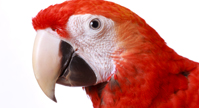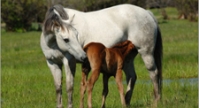E-Locus (Recessive Red/Yellow, Melanistic Mask Allele)
Description:
MC1R, also known as the extension gene, controls production of pigment in melanocytes. Melanocytes are cells that control the coloration of skin or fur. The dominant form of the gene, the "E" allele, allows the dog to produce eumelanin, which is a black pigment. This can appear either as E/e or E/E. A mutation in the MC1R gene causes the pigment-producing cells to only produce phaeomelanin instead of eumelanin. This turns all the eumelanin in the coat to phaeomelanin. This form of the gene is represented as the "e" allele. The e allele is recessive (e/e), meaning that a dog must have two copies of the MC1R mutation to express the yellow or red coat color. Recessive red can mask other color variants. It can even mask the merle coloration.
A third allele exists in the extension gene: Em. Em is also dominant. This means a dog can have Em/e or Em/Em in order for the Em coloration to be expressed. This causes the dog to have a black mask on their face. This mask is also known as a melanistic mask. This allele acts similarly to the E allele in that it causes a black-based coat. Because it is dominant, a dog only needs one copy of the Em allele to express this trait. In solid, black dogs with a copy of the Em allele, the mask is hidden. This is because the mask and the fur color are both black, and the mask then becomes “invisible.” However, the dog can still pass on the melanistic mask to future offspring, even if the mask cannot be seen. The e/e genotype can vary in expression between different breeds. In some breeds, the difference between a black/brown dog and a yellow dog is obvious (i.e. Labrador Retrievers). However, in other breeds, such as Cocker Spaniels, this difference may be more subtle. Other breeds express the e/e phenotype as a red color.
It is important to note that the extension gene is only one of four important genes in determining the coat color of a canine. The dog's color can vary greatly with different mutated alleles on other genes. Dogs that are e/e will always be yellow. However, there is a great deal of variation of dogs that are E/E or E/e depending on the B locus, A locus, K locus, and D locus. To find out more about these variations, make sure to read the corresponding articles.
E Locus Testing:
The MC1R gene, or E Locus, has three possible forms: Black (E), melanistic mask (Em), and Red/Yellow (ee). The E-Allele test determines how many copies of the recessive "e" alleles a dog carries. The Em-Allele test determines how many copies of the melanistic mask allele a dog carries.
Sample Type:
Animal Genetics accepts buccal swab, blood, and dewclaw samples for testing. Sample collection kits are available and can be ordered at Canine Test Now.
Testing is Relevant for the Following Breeds:
All breeds.
Results:
Animal Genetics offers DNA testing for both E and Em alleles. The genetic test verifies the presence of these mutations and presents results as one of the following:
e-Allele Results:
| E/E | Black | The dog carries two copies of the dominant E allele. The dog will produce normal black pigmentation, and will always pass on the "E" allele to any potential offspring. |
| E/e | Black carries Red/Yellow | Both the dominant and recessive copies of the E allele are present. The dog will produce normal black pigment, but carries the allele responsible for the Red/Yellow phenotype. The dog can pass on either allele to potential offspring. |
| e/e | Red/Yellow | Two copies of the recessive allele are present. The dog has a Red/Yellow coat, and will always pass on the recessive allele to all potential offspring. |
Em-Allele Results:
| Em/Em | Black Mask | The dog carries two copies of the melanistic mask allele. The dog has a melanistic mask, and will always pass on a copy of the Em allele to potential offspring. All offspring will also have a melanistic mask. |
| Em/n | Black Mask | One copy of the melanistic mask allele is present, and the dog will have a black mask. The dog has a 50% chance of passing on this allele to potential offspring. |
| n/n | No Black Mask | Dog tested negative for the melanistic mask allele. The dog will not have a black mask, and cannot pass a copy on to any offspring. |
Combination E-Locus Results:
| E/E | Black | Dog carries two copies of the dominant E allele. The dog does not carry the alleles for the black mask or recessive Red/Yellow. |
| Em/Em | Black Mask | Dog carries two copies of the black mask allele, and will always pass on a copy of the mask allele to any offspring. The dog does not carry recessive Red/Yellow. |
| Em/E | Black Mask | Dog carries one copy of the mask allele, and does not carry the allele for recessive Red/Yellow. |
| Em/e | Black Mask | Dog carries one copy of the mask allele and one copy of the recessive allele. The dog could pass on either allele to any offspring. |
| E/e | Black | Dog carries one copy of the recessive allele, and does not carry the mask allele. |
| e/e | Red/Yellow | Dog has two copies of the recessive allele, and does not have the mask allele. The dog will always pass on a copy of the recessive allele to any offspring. |
Submit a Sample for Testing:
To submit a sample for testing please go to Canine Test Now.
To order a sample collection kit please go to Order Sample Collection kits.
Cost per sample is $40.00. Please see our Canine Fee Schedule for all test rates.










